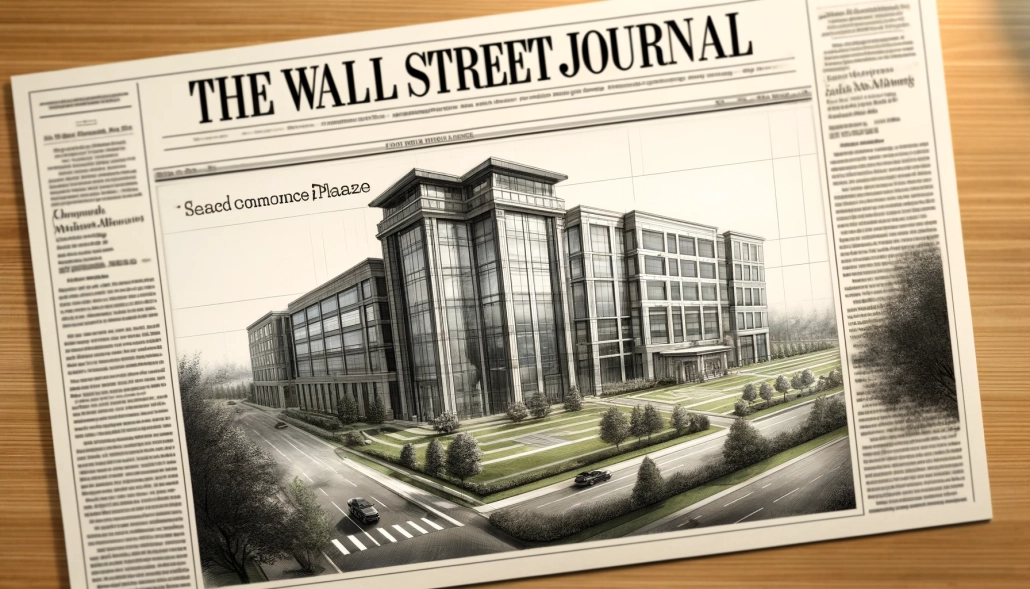Wall Street Journal Prime Rate
The consensus interest rate charged by ten of America’s largest banks to their most creditworthy customers, typically for loans with short-term maturities. The Wall Street Journal Prime Rate (or WSJP) is determined through a market survey and updated in WSJ when seven or more of the participating banks adjust their prime rates. It’s an essential benchmark in finance, serving as a base rate for various lending products including mortgages, auto loans, and variable credit lines.
The WSJP is approximately 300 basis points (3%) above the federal funds rate, reflecting the Federal Reserve’s monetary policy influences. It is often utilized by commercial real estate lenders as an index upon which loans are price, e.g., WSJP + 1.5%.
- Click here to find the current WSJP rate
Putting “Wall Street Journal Prime Rate (WSJP)” in Context
In Eastwood, a burgeoning commercial hub, the Eastwood Commerce Plaza is a (hypothetical) new office project by Blue Horizon Developers, consisting of 150,000 square feet of Class A office space. This complex serves as a cornerstone for the economic growth of the area, attracting tech companies, legal offices, and a regional bank.
- Base Rate: The interest rate for the loan is derived from WSJP as the base rate plus a 1.5% spread. With the WSJP at 8.50%, the effective rate is 10.00%.
- Interest Calculations:
- Annual Interest: Assuming annual compounding, the annual interest is $5 million (10.00% of $50 million).
- Monthly Interest: This equates to monthly interest owed of about $416,667.
- Interest Reserve: Since there is no operating income during the construction phase, an interest reserve is setup to cover the interest payments until the project is stabilized.
- Loan Transition: Upon stabilization of Eastwood Commerce Plaza, Blue Horizons plans to sell the building to a core office investor. That new owner will likely place long-term, low leverage, fixed rate debt on the property. That fixed rate debt would likely be priced over U.S. Treasury securities (e.g. 4.50% + 250bps = 7.00% fixed rate).
This mini-case of the Eastwood Commerce Plaza illustrates one role of the Wall Street Journal Prime Rate plays in commercial real estate. By understanding these financial mechanisms, Blue Horizon Developers is better able to plan for a successful development and profitable exit.
Frequently Asked Questions about the Wall Street Journal Prime Rate (WSJP) in Commercial Real Estate
What is the Wall Street Journal Prime Rate (WSJP)?
The WSJP is “the consensus interest rate charged by ten of America’s largest banks to their most creditworthy customers.” It typically applies to short-term loans and is a common benchmark for various lending products.
How is the WSJP determined?
The rate is updated when “seven or more of the participating banks adjust their prime rates,” based on a survey conducted by the Wall Street Journal.
What is the typical relationship between the WSJP and the federal funds rate?
The WSJP is “approximately 300 basis points (3%) above the federal funds rate,” reflecting monetary policy conditions set by the Federal Reserve.
How is WSJP used in commercial real estate financing?
Commercial real estate lenders often use the WSJP “as an index upon which loans are priced,” for example, WSJP + 1.5%.
How did Blue Horizon Developers use the WSJP in the Eastwood Commerce Plaza case?
They secured a construction loan priced at WSJP + 1.5%. With WSJP at 8.50%, their effective interest rate was 10.00% on a $50 million loan, resulting in $5 million annual interest.
What happens to the loan once the property stabilizes?
Once stabilized, Blue Horizon Developers plan to sell the building. The buyer will likely place “long-term, low leverage, fixed rate debt” priced over U.S. Treasury yields.
Where can I find the current WSJP rate?
You can find the current WSJP rate by clicking the link provided in the post that says “Click here to find the current WSJP rate.”
Click here to get this CRE Glossary in an eBook (PDF) format.

